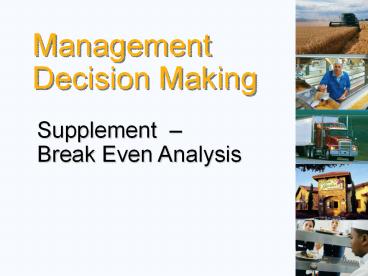Heizer/Render 9E - PowerPoint PPT Presentation
1 / 14
Title:
Heizer/Render 9E
Description:
Management Decision Making Supplement Break Even Analysis * This chart introduces breakeven analysis and the breakeven or crossover chart. As you discuss the ... – PowerPoint PPT presentation
Number of Views:165
Avg rating:3.0/5.0
Title: Heizer/Render 9E
1
Management Decision Making
Supplement Break Even Analysis
2
Break-Even Analysis
- Technique for evaluating process and equipment
alternatives - Objective is to find the point in dollars and
units at which cost equals revenue - Requires estimation of fixed costs, variable
costs, and revenue
3
Break-Even Analysis
- Fixed costs are costs that continue even if no
units are produced - Depreciation, taxes, debt, mortgage payments
- Variable costs are costs that vary with the
volume of units produced - Labor, materials, portion of utilities
- Contribution is the difference between selling
price and variable cost
4
Break-Even Analysis
Assumptions
- Costs and revenue are linear functions
- Generally not the case in the real world
- We actually know these costs
- Very difficult to accomplish
- There is no time value of money
5
Break-Even Analysis
Figure S7.6
6
Break-Even Analysis
Break-even point occurs when
TR TC or Px F Vx
7
Break-Even Analysis
Profit TR - TC Px - (F Vx) Px - F -
Vx (P - V)x - F
8
Break-Even Example
Fixed costs 10,000 Material
.75/unit Direct labor 1.50/unit Selling
price 4.00 per unit
9
Break-Even Example
Fixed costs 10,000 Material
.75/unit Direct labor 1.50/unit Selling
price 4.00 per unit
10
Break-Even Example
11
Break-Even Example
Multiproduct Case
where V variable cost per unit P price per
unit F fixed costs W percent each product
is of total dollar sales i each product
12
Multiproduct Example
Fixed costs 3,500 per month
13
Multiproduct Example
Fixed costs 3,500 per month
14
Multiproduct Example
Fixed costs 3,500 per month































